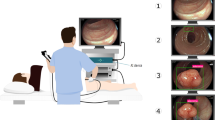Abstract
Purpose
Aim of the study was the evaluation of high-definition white light (HDWL) i-Scan endoscopy for diagnostic prediction of histology, inter- and intraobserver agreement for colorectal polyps.
Methods
In this prospective single-center cohort study, a skilled endoscopist, with HDWL i-Scan, predicted on real-time the histology of 150 polyps from 78 patients undergoing colonoscopy. Subsequently, four endoscopists, not involved in the collection of cases, predicted the polyps' histology (neoplastic vs nonneoplastic) and repeated the assessment after 6 months.
Results
Real-time assessment of the lesions predicted a correct histology in 138/150 cases with a sensitivity, specificity, and accuracy of 95, 82, and 92 %, respectively. Sensitivity, specificity, and accuracy of post-acquisition evaluation were 87.7, 61.7, and 82.2 %, respectively. The κ values of inter- and intraobserver agreement of prediction of histology were 0.462 (0.373–0.537) and 0.657 (0.523–0.917). Among the subset of polyps (n = 82) with good/excellent quality image, sensitivity and accuracy of HDWL i-Scan improved (97 %, p = 0.003 and 94 %, p = 0.002, respectively) as well as κ value of interobserver agreement (0.699).
Conclusions
HDWL i-Scan technology helps for characterization of polyps of the colon with good accuracy even if it cannot replace, at the moment, the histopathological examination. Reproducibility among operators is supported by a moderate substantial interobserver and intraobserver agreement.


Similar content being viewed by others
References
Winawer SJ, Zauber AG, Ho MN, O'Brien MJ, Gottlieb LS, Sternberg SS et al (1993) Prevention of colorectal cancer by colonoscopic polypectomy. The National Polyp Study Workgroup. N Engl J Med 329:1977–1981
Ignjatovic A, East JE, Suzuki N, Vance M, Guenther T, Saunders BP (2009) Optical diagnosis of small colorectal polyps at routine colonoscopy (Detect InSpect ChAracterise Resect and Discard; DISCARD trial): a prospective cohort study. Lancet Oncol 10:1171–1178
Hassan C, Pickhardt PJ, Rex DK (2010) A resect and discard strategy would improve cost-effectiveness of colorectal cancer screening. Clin Gastroenterol Hepatol 8:865–869
Kudo S, Tamura S, Nakajima T, Yamano H, Kusaka H, Watanabe H (1996) Diagnosis of colorectal tumurous lesions by magnifying endoscopy. Gastrointest Endosc 44:8–14
Huang Q, Fukami N, Kashida H, Takeuchi T, Kogure E, Kurahashi T et al (2004) Interobserver and intra-observer consistency in the endoscopic assessment of colonic pit patterns. Gastrointest Endosc 60:520–526
Amateu SK, Canto MI (2010) Enhanced mucosal imaging. Curr Opin Gastroenterol 26:445–452
Goetz M, Kiesslich R (2009) Advanced imaging of the gastrointestinal tract: research vs. clinical tools? Curr Opin Gastroenterol 25:412–421
Sauk J (2010) High-definition and filter-aided colonoscopy. Gastroenterol Clin North Am 39:859–881
Kodashima S, Fujishiro M (2010) Novel image-enhanced endoscopy with i-scan technology. World J Gastroenterol 16:1043–1049
Anonymous (2003) The Paris endoscopic classification of superficial neoplastic lesions: esophagus, stomach, and colon: November 30 to December 1, 2002. Gastrointest Endosc 58:S3–43
Rastogi A, Bansal A, Wani S, Callahan P, McGregor DH, Cherian R et al (2008) NBI colonoscopy: a pilot feasibility study for the detection of polyps and correlation of surface patterns with histologic diagnosis. Gastrointest Endosc 67:280–286
Tanaka S, Sano S (2011) Current status and the challenges of NBI diagnosis for colorectal tumor. Aim to unify the Narrow Band Imaging (NBI) magnifying classification for colorectal tumors: current status in Japan from summary of the consensus symposium in the 79th Annual Meeting of the Japan Gastroenterological Endoscopy Society. Dig Endosc 23:S131–S139
Landis JR, Koch GG (1977) The measurement of observer agreement for categorical data. Biometrics 33:159–174
Pohl J, Schneider A, Vogell H, Mayer G, Kaiser G, Ell CG (2011) Pancolonic chromoendoscopy with indigo carmine versus standard colonoscopy for detection of neoplastic lesions: a randomised two-centre trial. Gut 60:485–490
Brown SR, Baraza W, Hurlstone DP (2007) Chromoscopy versus conventional endoscopy for the detection of polyps in the colon and rectum. Cochrane Database Syst 4:CD006439
van den Broek FJ, Reitsma JB, Curvers FP, Dekker E (2009) Systematic review of narrow-band imaging for the detection and differentiation of neoplastic and nonneoplastic lesions in the colon. Gastrointest Endosc 69:124–135
Pohl J, Lotterer E, Balzer C, Sackmann M, Schmidt KD, Gossner L et al (2009) Computed virtual chromoendoscopy versus standard colonoscopy with targeted indigo carmine chromoscopy: a randomized mulicentre trial. Gut 58:73–78
Aminalai A, Rösch T, Aschenbeck J, Mayr M, Drossel R, Schröder A et al (2010) Live image processing does not increase adenoma detection rate during colonoscopy: a randomized comparison between FICE and conventional imaging. Am J Gastroenterol 105:2383–2388
Hoffman A, Sar F, Goetz M, Tresch A, Mudter J, Biesterfeld S et al (2010) High definition colonoscopy combined with i-Scan is superior in the detection of colorectal neoplasia compared with standard video colonoscopy: a prospective randomized controlled trial. Endoscopy 42:827–833
Hoffman A, Kagel C, Goetz M, Tresch A, Mudter J, Biesterfeld S et al (2010) Recognition and characterization of small colonic neoplasia with high-definition colonoscopy using i-Scan is as precise as chromoendoscopy. Dig Liver Dis 42:45–50
Lee CK, Lee SH, Hwangbo Y (2001) Narrow-band imaging versus I-Scan for the real-time histological prediction of diminutive colonic polyps: a prospective comparative study by using the simple unified endoscopic classification. Gastrointest Endosc 74:603–609
Rex DK (2009) Narrow-band imaging without optical magnification for histologic analysis of colorectal polyps. Gastroenterology 136:1174–1181
Rastogi A, Pondugula K, Bansal A, Wani S, Keighley J, Sugar J et al (2009) Recognition of surface mucosal and vascular patterns of colon polyps by using narrow-band imaging: interobserver and intraobserver agreement and prediction of polyp histology. Gastrointest Endosc 69:716–722
Butterly LF, Chase MP, Pohl H, Fiarman GS et al (2006) Prevalence of clinically important histology in small adenomas. Clin Gastroenterol Hepatol 4:343–348
Gupta N, Bansal A, Rao D, Early DS, Jonnalgadda S, Edmundowicz SA et al (2012) Accuracy of in vivo optical diagnosis of colon polyp histology by narrow-band imaging in predicting colonoscopy surveillance intervals. Gastrointest Endosc 75:494–502
Author information
Authors and Affiliations
Corresponding author
Rights and permissions
About this article
Cite this article
Pigò, F., Bertani, H., Manno, M. et al. i-Scan high-definition white light endoscopy and colorectal polyps: prediction of histology, interobserver and intraobserver agreement. Int J Colorectal Dis 28, 399–406 (2013). https://doi.org/10.1007/s00384-012-1583-7
Accepted:
Published:
Issue Date:
DOI: https://doi.org/10.1007/s00384-012-1583-7




